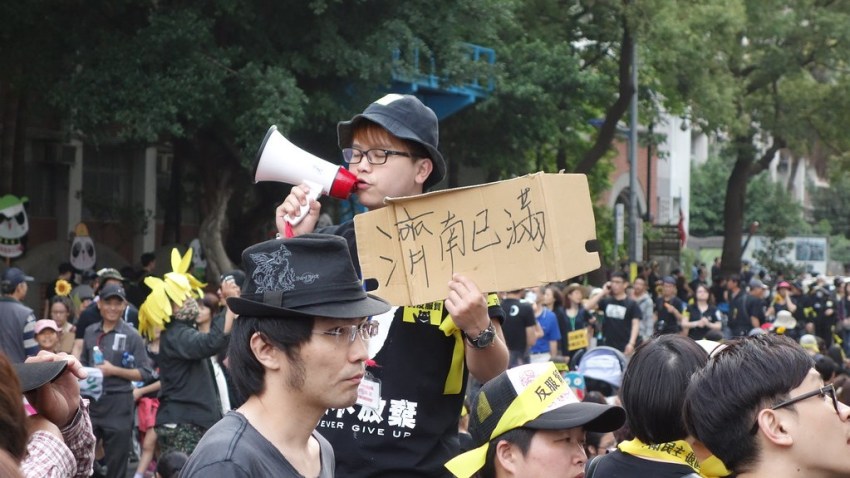On March 19, students occupied Taiwan’s legislature to protest President Ma Ying-jeou and his Kuomintang (KMT) government’s handling of the services trade agreement with China (CSSTA). With strong public backing, the protest swelled into what is now known as the Sunflower Movement. The movement won the support of major KMT figures for a compromise that would see the services pact, and any future agreements with China, undergo more thorough—and public—scrutiny. The protest leaders have now announced that they will vacate the legislature on Thursday evening.
These dramatic events are forcing a rethink about the very nature of the China-Taiwan relationship. Until now, many observers had taken the magnetic attraction of the Chinese market for Taiwan as a given. After all, China has overtaken Japan as the world’s second-largest economy, and its growth continues to lead the world despite signs of cooling. Taiwan, on the other hand, remains in a prolonged slump. The Economic Cooperation Framework Agreement (ECFA) that both sides of the Taiwan Strait
signed in 2010 was therefore seen as the first step toward Taiwan’s economic integration with China.
Indeed, things did begin to change on the ground. Tourists from the mainland are now a common sight around Taiwan. And it is widely believed that Beijing uses its vast resources to influence the island’s media and politics. It was not surprising, then, that an observer like John Mearsheimer
would invite his readers to say goodbye to Taiwan earlier this year. Nor did it seem unreasonable for South Koreans to fret over China’s manufacturing base combining with Taiwan’s technological know-how. They even coined a portmanteau for this looming threat to their exports—“
Chiwan”.
So, how to make sense of this mismatch between accepted wisdom and the dramatic events unfolding in Taiwan? To start with, predictions of Taiwan’s steady advance toward integration with China had overlooked the fact that the Taiwanese people were not buying it. The man supposedly leading Taiwan’s rush to China, Ma, has a single-digit approval rating. True, the opposition Democratic Progressive Party (DPP) has struggled to present a unified, credible alternative. But as Michael Cole
has highlighted, a powerful and popular bipartisan movement has risen up in reaction to the Ma government. The Sunflower Movement is the product of years of organizing—and anger.
It is also important to understand what the protesters are not unhappy about. The protesters, and the Taiwanese in general, are not particularly against trade liberalization. Taiwan’s trade agreements with Singapore and New Zealand passed the legislature without incident. Nor are the Taiwanese opposed to economic engagement with the mainland. Millions of Taiwanese live and work in China, and Taiwanese have invested billions of dollars there. Even the specific economic impact of the services agreement does not seem to be a major issue. Sure, there would be those in Taiwan who would lose out if the agreement comes into effect. But as most Taiwanese are well aware, China is dangling the agreement as a “carrot” to bring Taiwan toward unification, and the services agreement is undoubtedly more favorable than what China would offer other countries.
The fact that Beijing aims to leverage the CSSTA to undermine Taiwan’s sovereignty is of course a concern. But it’s doubtful that many Taiwanese see the services pact as the coup de grace to Taiwan’s de facto independence. And it’s arguably better that the leadership in Beijing is sending carrots in Taiwan’s direction to achieve unification as opposed to sticks—or missiles. So fear of China is not the main impulse behind the Sunflower Movement, either.
The real driving force that brought the protesters into the legislature and out onto the streets, and the force that has seen the public support the movement so strongly, is the growing conviction that Ma cannot be trusted to act in the best interests of Taiwan’s people. It was the government’s reneging on its promise to submit the pact to proper legislative review—not the mere existence of the pact itself—that spurred the protesters into action.
Ma
has labeled the protesters and their occupation of the legislature a threat to Taiwan’s democracy. The reality is quite the opposite. The Ma government lacks the popular mandate to unilaterally decide on matters like the CSSTA that have such serious implications for Taiwan’s future. In these circumstances, shutting down the malfunctioning legislature is profoundly democratic. It shows that the Taiwanese cherish their hard-won rights, and is undoubtedly a positive development in Taiwan’s continuing democratization. It is now up to politicians on both sides of the political divide to live up to the reinvigorated expectations of Taiwan’s people.
Finally, it needs to be emphasized that this assertion of rights has not come at significant cost to Taiwan’s economy. As even CSSTA boosters acknowledge, the projected economic benefit of the agreement
is a mere 0.03 percent of Taiwan’s GDP over 10 years. Fears that the protests have undermined Taiwan’s reputation as a negotiator of free trade agreements are also misguided, as countries interested in negotiating an agreement with Taiwan will appreciate the special context of cross-strait relations.
In fact, the Sunflower Movement may well enhance Taiwan’s prosperity. As William Easterly controversially—yet convincingly—
argues in his new book, economic development has never progressed beyond a certain point without an expansion of political rights. And it is checks on the power of governments to abuse individual rights that have historically driven economic growth. The Taiwanese have a basic right to a legislature and a government that represents their interests. Ultimately, it is the strengthening of these rights that holds the key to Taiwan’s continued economic growth, not a services trade agreement designed by technocrats, and agreed to behind closed doors.
Joel Atkinson is a research fellow at the Institute for Poverty Alleviation and International Development (IPAID) at Yonsei University in South Korea. He is managing editor of the institute’s peer-reviewed journal, JPAID and the author of “Australia and Taiwan” (Brill, 2012).

